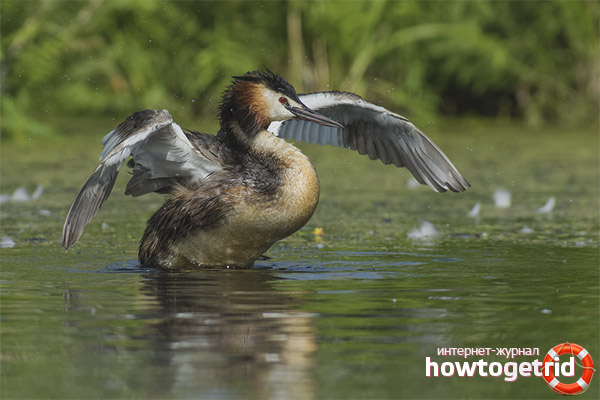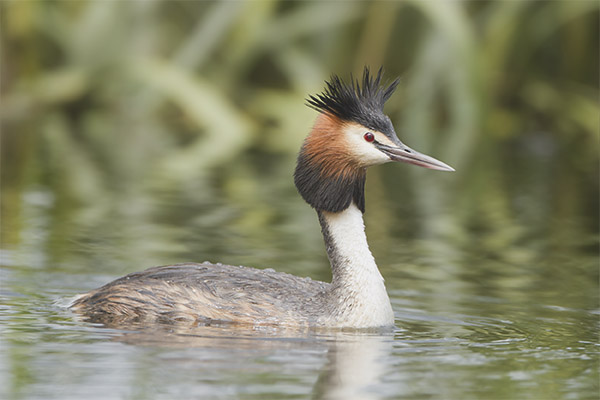The content of the article
Chomga is a water bird of the toadstool family that does not exceed the size of a duck. The sophisticated image of a chomga perfectly harmonizes with a long graceful neck and a sharp straight beak. An uninitiated person, having heard the name of a bird, might think that it is a matter of mushroom fungi. However, the bird has nothing in common with the mushroom nature. The name “Great Grebe” was acquired by the specific taste and smell of its own meat. Repellent taste and unpleasant scent of the game makes the bird free from human encroachment. This becomes especially relevant in the spring, when many hunters are activated and the population of ducks is significantly reduced. It can be said that nature thus protected the scum from extermination. What is more interesting this graceful bird, try to figure it out.
The appearance of a noble chomgi
Learn a great toadstool is not difficult, even from afar. On the head in the summer, vertical feathers grow, which resemble horns or a crown. They have a multi-colored color, which favorably distinguishes the bird compared to other representatives of avifauna. The bird is considered rather large, its average weight is about a kilogram. The back is brown or red, and the belly, neck and head are white in color. In the spring, in the early stages of the plumage, a red collar is formed around the neck, which by winter disappears without a trace.
Males differ from females primarily in size. The length of the wing of a male individual can exceed 20 cm. The body length reaches 50 cm, and the wingspan can reach up to a meter. Thin beak has a reddish color. The peculiarity of homga are its paws, which work in the form of screws. With them, the bird is able to quickly turn 90 degrees, change the direction of its movement, both along and across the original trajectory. There are special membranes on the paws of chomgi, which allow it to dive several meters into the water, to swim at a depth and in general, to control the body perfectly in the water column.
Today, ornithologists around the world know about 18 species of chomgi. Due to the unfavorable ecological situation and the widespread pollution of water bodies, 5 of these species are listed in the Red Book as an endangered species. A few decades ago, the poachers attacked the beautiful plumage of birds, when women's fur coats with similar fur inserts were in fashion. This also played a decisive role in reducing the population of the toadstool.
Habitat great toadstool
Features lifestyle chomgi
In the water, the snowman swims and dives perfectly, but on land it feels rather clumsy - the short legs allow you to move very relatively along the coast.For this reason, the duck in most cases swims, other ways of movement are considered forced. For the flight there should also be a weighty basis, for example, a flight for the winter. When a danger occurs, a large grebe is more likely to dive under the water, where it may not be afraid for its life, since in the water element this bird simply has no equal. Homie expertly presses the wings to the body in order to improve the hydrodynamics, this allows the waterfowl to gain incredible speed at depth. This is a great way to protect against enemies, which is enough for a scomga. Large birds, for example, a crow or a marsh harrier can ruin nests and eat eggs of a great grebes. As soon as chomgi chicks hatch and get into the water, they can become a tasty food for large predatory fish.
The main food of the great toadstool

Since water is the natural habitat of combs, it feeds on what it can get in the pond. The main ration consists of medium and small fish, which the grebe duck swallows completely. Sometimes under water, along with the fish, the bird can swallow its own feathers, which subsequently the toadstool simply regurgitates back, along with fish stones.In addition, the sandfish feeds on other aquatic inhabitants - frogs, crustaceans, various mollusks and insects. If the birds arrived in early spring, when the reservoirs are still covered with ice, the grebe gladly regales the first spring vegetation. If the ponds and stagnant lakes do not freeze for the winter, the bird in most cases does not fly away for the winter, it only needs to dive deep enough into the water to get food for itself. It dives really deep; there have been cases when fishermen found birds stuck in fishing nets at a depth of 25-30 meters. In addition, the grebe duck is able to hold air for a long time and stay under water for 15-20 seconds.
Chomgi nesting
In the mating season, individuals of the great toadstool become incredibly beautiful and refined. A spectacular forelock sprouts on the head, and a collar appears around the head that looks more like sideburns. Marriage games are long and intense - individuals flaunt each other, pulling and showing to the partner the long neck and span of large wings. At the same time there are loud sounds that are usually heard for hundreds of meters around.After the birds have chosen a partner for themselves, the couple begins to build a nest. As a rule, the sandstone builds a nest on water from reeds or dry plants that do not sink. In some cases, the nest can be built on an island of floating peat. From the side, such a floating nest seems to be a bunch of unnecessary garbage, although in reality there is a hollow inside the dry stalks and leaves. In the depth of the nest there are several large white eggs, they have an unusual shape, sharp at the edges.
Over time, the eggs of the snow-white become brown, acquiring a swamp hue due to the fact that the surrounding vegetation in the water rots. Such a nest in the water in a half-drunk state is a guarantee of the safety of the life of the chicks. Eggs hatch 3-4 weeks, during which the female tries not to leave them. If it is forced to leave, the eggs are simply closed on top with grass and reeds. With an interval of several days, the chicks hatch one after another. At birth, they already have a small fluff, the chicks hiding under the maternal wing. Almost immediately, the female puts the young on their back and begins to dive with them into the water in order to accustom them to the natural environment.
The chicks become fully grown after 2-3 months, when the mother releases them to free swimming and they begin to take care of their own food. In the wild, Chomga lives about 10-15 years, in conditions of nature reserves it is much more - almost 25 years.
Video: great crested grebe (Podiceps cristatus)











To send